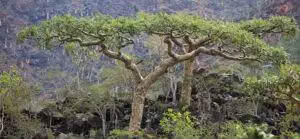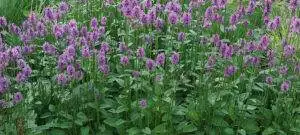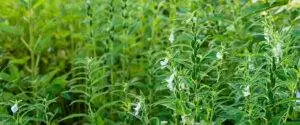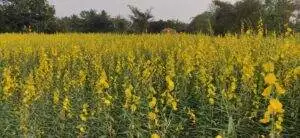Drought-Tolerant Plants for Dry Climates
Drought-tolerant plants are those that can be chosen for a desert garden or xeriscaping scheme. They can cope with low rainfall and will require little water throughout the year. So they are among the best choices for a site in an arid climate.
In dry climate gardens, it is important to adopt the right strategies to catch, store and direct water wisely, and to conserve water on your property. A major part of the puzzle, however, is choosing the right plants. Drought-tolerant plants can often be used to minimize water use and create suitable planting schemes in dry-climate gardens.
Before we begin to choose plants, however, it is important to make sure we understand drought tolerance, and what is really meant by the term. And it is also important to make sure that we understand that what works well in one dry climate garden won't necessarily work as well in another.
Once we understand these things, we can begin to create xeriscaping plans appropriate to place, incorporating the right plants for the location.
Understanding Drought Tolerance
Drought tolerance is a term used to describe the degree to which a plant can maintain its biomass during arid or drought conditions. Plants that are described as 'drought tolerant' are naturally adapted to dry conditions and have developed a range of complex strategies to deal with low or intermittent water availability.
When plants are subjected to water shortages, whether these are short or longer-term, they can respond in a number of different ways. There are short-term responses in leaves, stems, and roots, and also longer-term responses involving both above and below-ground portions of the plant.
In nature, in arid or drought-prone regions, plants have developed natural drought tolerance adaptations in order to cope with local conditions. We can divide naturally drought-tolerant plants into four key groups:
- Drought-escaping plants
- Drought-evading plants
- Drought-enduring plants
- And Drought-resisting plants
Drought-escaping plants
These are annual plants that grow in an arid climate only during times when there is sufficient water availability for them to complete their life cycles. These plants persist through dry seasons as seeds.
Drought-evading plants
These are non-succulent perennials that grow over a number of years in a drought-prone or arid climate but restrict their growth to periods when there is sufficient water available. They often drop their leaves and enter periods of dormancy during drought but may also be leafless and photosynthesize through their stems.
Drought-enduring plants
These are evergreen shrubs known as xerophytes, which have extensive root systems and which also display certain other physiological and morphological adaptations. Their root systems and other adaptations allow them to maintain growth even during extreme periods of drought.
Drought-resisting plants
These drought-tolerant plants are perhaps the best well-known. They are succulent perennials that have evolved to store water within their stems and/or leaves that can be used at utmost need during droughts.
Each of these types of dry climate and drought-adapted plants have a number of physiological adaptations that reduce stress on plants and allow them to function in environments where most other plants could not easily survive.
Other plants may tolerate periods of water scarcity to varying degrees, but cannot truly be called drought-tolerant. However, it is worth noting that these may also be very useful in many dry-climate gardens.
Understanding Dry Climate Gardens
Before you think about selecting plants for a dry climate garden, it is important to think about what type of dry climate we are talking about.
First of all, it is important to determine whether you are dealing with a true arid, or desert climate, a semi-arid climate, or just a garden that can dry out a little during certain times of the year.
Desert Climates
Desert or arid climate types, BWh and Bwk in the Köppen climate classification system, are the most extreme forms of dry climate. In these climate zones, water is lost through evaporation and transpiration more quickly than it can be replaced through precipitation.
Bwh denotes a hot desert climate, the second most common climate type on earth after the polar climate, covering 14.2 percent of the earth's surface. These hot desert climates have a mean annual temperature above 18 degrees C.
Bwk denotes a cool desert climate, typically located in temperate zones and usually in the leeward rain shadow of high mountains which significantly reduces rainfall.
To determine whether or not an area has a true arid climate, the precipitation threshold (in millimeters) is determined.
This is calculated by multiplying the annual average temperature by 20, then adding either 280 (if more than 70% of the rainfall occurs in the hotter half of the year), 140 (if 30-70% of rainfall occurs during this warmest period), or 0 (if less than 30% of precipitation occurs during this time).
If the area's annual precipitation is less than half the precipitation threshold, then it is classified as a true arid, or desert climate.
Semi-Arid Climates
Semi-arid climates (Bsh and Bsk in the Köppen climate classification system) are zones where the annual precipitation is less than the precipitation threshold but more than 50% of the threshold.
Hot semi-arid climates have mean annual temperatures above 18 degrees C. and experience hot to extremely hot summers and warm to cool winters, with some to minimal precipitation.
Cold semi-arid climates are in elevated locations within temperate zones, typically in continental interiors some distance from large bodies of water. Unlike hot semi-arid climates, these zones can have cold and possibly even freezing winters.
In arid and semi-arid climate zones, choosing drought tolerant plants can, of course, be particularly important, but such plants can also be useful for water-wise gardens in zones that fall short of true aridity but where dry conditions can be experienced at certain times of year, and where reducing water use and conserving water can still be very important.
Xeriscaping for Dry Climate Gardens
Xeriscaping is the term given to landscaping or garden design that reduces or eliminates the need for irrigation.
It is particularly important within desert or semi-arid climate zones, but can also be beneficial in other areas where water availability may be relatively low, and even where better water management is required, even where precipitation is higher.
The emphasis is on plant selection for water conservation, and on taking steps to reduce water losses from the area.
Xeriscaping was coined by Denver water in 1981. It is a portmanteau word that joins the Greek prefix xero (which comes from the Greek word for dry) with the word landscaping. It is a term that is synonymous with the terms water-conserving landscaping, drought-tolerant landscaping and sometimes 'smart' landscaping.
What Xeriscaping Is and Is Not
Unfortunately, there is often a public misconception about what xeriscaping looks like. People are often reluctant to embrace this idea because they associate xeriscaping with ugly expanses of prickly and spiny cacti and vast areas of gravel.
Eco-conscious gardeners living in arid areas often understand that giving up their irrigated lawn is the best idea. But some, especially those with young children, are reluctant to fully embrace xeriscaping because they believe it involves a harsh-looking garden filled with sharp spikes and prickly thorns.
Effective xeriscaping plans for certain desert regions do often include some gravel and cacti, but these types of planting schemes certainly do not need to be ugly. Nor is it always necessary to include spiny or prickly plants that might not be ideal for all gardens (for example, if you have young children running around).
A xeriscaping plan can look like a gravel garden with native desert plants. However, in many areas, xeriscaping schemes can take very different forms. For example, a well-designed food forest might be an effective form of xeriscaping – as might a native meadow scheme with drought-tolerant wildflowers from the area and native grasses in certain regions... It certainly is not simply about placing some desert plants in gravel in your garden.
Remember, working out the details of a xeriscaping scheme involves looking carefully at natural environments in your area, and thinking about how you can mimic them to create a garden that can thrive where you live within minimal intervention from you - especially in terms of water provision.
Selecting Plants for a Xeriscaping Scheme
Depending on the precise location and the conditions to be found there, there are plenty of wonderful and fascinating drought-tolerant plants that might be included in xeriscaping scheme.
A native garden for some areas may conjure up images of thorny bushes, cacti, and sharp-leaved succulents. But no matter where you live, there will be native plants to consider which would be well-suited for your needs.
Even if you don't exclusively use native plants, native plants are typically a good place to begin, since they will often use less water, and be best adapted to the natural growing conditions that you can provide.
Plants certainly don't have to be sparse in a xeriscaping scheme. In most situations, it will be possible to carefully combine plants to create relatively lush and attractive schemes that can cope with the low natural rainfall in a given area, or with minimal, water-wise irrigation in some areas.
Drought-tolerant plants can form the heart of a xeriscaping scheme – but they might not be the only plants included. In some areas, using drought-tolerant plants and other permaculture ideas can allow you to create an environment where even certain plants not ideally suited to the climate can actually thrive – which can be especially useful for food production.
Choosing the right plants for a permaculture xeriscaping scheme is not the only consideration, and when selecting drought tolerant plants, it will not only be important to choose plants suited to your area, but also to think about how to integrate those plants into the scheme for the entirety of the space available.
Other Permaculture Solutions for Dry Climate Gardens
Remember, choosing the right plants is only part of the solution for a dry climate garden. In permaculture we also think about:
- Managing Water Effectively on a Property
- Mulching the Soil Around Plants
- Using Drought-Tolerant Plants to Improve Growing Conditions for Other Plants
Managing Water Effectively on a Property
Managing water is always an important concern on many properties, but it is of course an especially pressing concern where water availability is low in semi-arid or desert climates. Choosing plants that can cope with the environment is only part of the equation.
Managing water effectively in dryland environments can often mean employing other permaculture solutions such as swales, or other earthworks. By using earthworks in combination with drought-tolerant plants (often those native to the region), we can create environments more hospitable to plant growth and food cultivation.
Creating an effective xeriscaping scheme in a dry climate garden might also involve the creation of a rain garden to which rainwater harvested from the roof, or other hard surfaces, or grey water from a home might be directed.
Specific food-producing schemes for dry environments are also of great benefit when managing water in dry-climate gardens.
For example, you might consider keyhole beds with composting and watering points at their centers. You might consider a wicking bed with a reservoir of water at the base. You might consider something like a waffle garden, or basin planting scheme.
For irrigation of your crops, you might adopt some great small-scale water-saving options, such as simple drip irrigation, clay pot (olla) irrigation, or use watering globes. Or you might even consider a hydroponic or better yet, an aquaponic system to grow food in water rather than soil and bypass the watering/ irrigation issues of a dry climate.
There are many different options to consider that allow gardeners to work to grow more traditional produce while still minimizing water use on their properties, even when not growing particularly drought-tolerant crops.
However, especially in the driest areas, it can also be interesting to explore more unusual and less well-known edibles of dryland environments. Native edibles from dry environments can be diverse and sustainable options for food production in areas where rainfall is scarce.
Mulching the Soil Around Plants
Mulches can also be important in xeriscaping schemes. While gravels and other covers of this type might be used in some cases, in many cases it can be beneficial to add organic matter.
Increasing soil organic matter can be important in allowing gardens to thrive in arid or semi-arid areas. Adding mulch through sheet mulching won't only add organic matter to the soil and help with its moisture retention. It will also help to prevent issues with erosion, crust-forming, nutrient leaching etc...and protect the soil from hard. It can also help cool the soil surface in hot areas.
Using Drought-Tolerant Plants to Improve Growing Conditions
The key lies in not only selecting the right drought-tolerant plant species but also finding the correct ways to combine them, and learning how we can potentially use them in order to pave the way for other, less drought-tolerant species to be grown.
For example, we might often use drought-tolerant pioneer plants, perhaps a tree or shrub, to shade an area of soil and therefore create a more beneficial environment for other plants to grow.
Once shade has been established (and soil potentially amended with mulch), more moisture will be conserved in the soil below, allowing for the growth of somewhat less drought-tolerant plants.
The idea is to create thriving ecosystems – not simply planting schemes – by looking holistically at a site and its characteristics, and how plants and other elements can most usefully be combined.









